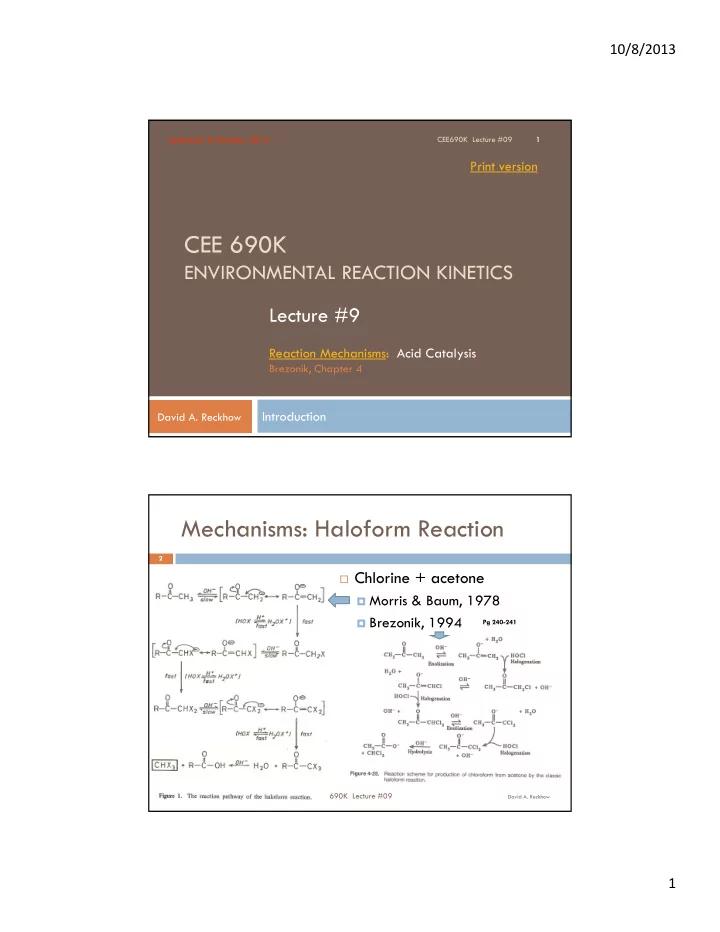

10/8/2013 Updated: 8 October 2013 CEE690K Lecture #09 1 Print version CEE 690K ENVIRONMENTAL REACTION KINETICS Lecture #9 Reaction Mechanisms: Acid Catalysis Brezonik, Chapter 4 Introduction David A. Reckhow Mechanisms: Haloform Reaction 2 Chlorine + acetone Morris & Baum, 1978 Brezonik, 1994 Pg 240-241 CEE690K Lecture #09 David A. Reckhow 1
10/8/2013 Haloform reaction: initial step 3 Three potential pathways to enolate Reaction with water (K O ), hydroxide (K OH ), and proton (K H ) k f =K O +K OH [OH - ]+K H [H + ] For acetone, the OH pathway dominates above pH 5.5 k [ H ][ A ] f What is k r ? K a k [ HA ] r David A. Reckhow CEE690K Lecture #09 Haloform: Doré’s diagram 4 Doré (1989) RLS is the first one CEE690K Lecture #09 David A. Reckhow 2
10/8/2013 Loss of intermediates in lab water 5 21C, ultrapure water (Nikolaou et al., 2001) CEE690K Lecture #09 David A. Reckhow Profile of TCP in water systems 6 1,1,1-Trichloropropanone concentrations compared to the corresponding TTHM concentration for all samples 5 San Francisco Jan(Cl 2 /NH 4 Cl) Charleston(ClO 2 / NH 4 Cl) San Francisco Apr (Cl 2 /NH 4 Cl) 1,1,1- trichloropropanone ( g/L) Monroe 4 Ann Arbor(O 3 /NH 4 Cl) East Bay( Cl 2 /NH 4 Cl) Cincinnati(Cl 2 ) 3 Minneapolis (NH 4 Cl/NH 4 Cl) Monroe(O 3 /Cl 2 ) Wyoming( Cl 2 /Cl 2 ) Pinellas County(Cl 2 /Cl 2 ) 2 Pinellas Co. Pinellas County(Cl 2 /NH 4 Cl) Knoxville Knoxville(ClO 2 /Cl 2 ) 1 0 0 20 40 60 80 100 120 140 CEE690K Lecture #09 Chloroform ( g/L) David A. Reckhow 3
10/8/2013 Loss in water heaters 7 Liu et al., 0.6 3.0 a No heating b 6 hrs incubation+heating 0.5 2.5 24 hrs incubation+heating 2013 48 hrs incubation+heating 72 hrs incubation+heating 0.4 2.0 1,1-DCP ( g/L) 96 hrs incubation+heating CP ( g/L) In review 1.5 0.3 No heating 1.0 0.2 6 hrs incubation+heating 24 hrs incubation+heating 48 hrs incubation+heating 0.5 0.1 72 hrs incubation+heating 96 hrs incubation+heating 0.0 0.0 0 20 40 60 80 100 120 0 20 40 60 80 100 120 Reaction Time (hr) Reaction Time (hr) 8.0 2.5 c d No heating No heating 6 hrs incubation+heating 6 hrs incubation+heating 24 hrs incubation+heating 2.0 24 hrs incubation+heating 6.0 48 hrs incubation+heating 48 hrs incubation+heating 72 hrs incubation+heating 72 hrs incubation+heating 96 hrs incubation+heating DCAN ( g/L) 1.5 96 hrs incubation+heating TCP ( g/L) 4.0 1.0 2.0 0.5 0.0 CEE690K Lecture #09 0.0 David A. Reckhow 0 20 40 60 80 100 120 0 20 40 60 80 100 120 Reaction Time (hr) Reaction Time (hr) Case Study: TCP Note: both TCP and TCAC refer to the 1,1,1-trichloropropanone 8 Observed loss of 1,1,1- trichloropropanone in distribution systems Lab studies show that chloroform is the product Logically presumed to be a simple hydrolysis Reckhow & Singer, 1985 “Mechanisms of Organic Halide Formation During Fulvic Acid Chlorination and Implications with Respect to Preozonation”, In Jolley et al., Water Chlorination; CEE690K Lecture #09 David A. Reckhow Chemistry, Environmental Impact and Health Effect, Volume 5, Lewis. 4
10/8/2013 TCP (cont.) 9 Ionic strength effects ln k H 4 . 81 1 . 4 I log k H 2 . 08 0 . 6 I Rate with chlorine Increases greatly High intercept k 0 . 024 32 HOCl T T CEE690K Lecture #09 David A. Reckhow Disagreement with prior study 10 Gurol & Suffet showed 10x higher rate constants Phosphate? CEE690K Lecture #09 David A. Reckhow 5
10/8/2013 Putting it together 11 CEE690K Lecture #09 David A. Reckhow Catalysis 12 Homogeneous Catalysis Definition Liquid-phase substances which react with the main reactants or intermediates thereby providing an alternative pathway to products with a lower activation energy or a higher frequency factor. Catalysts are often regenerated over the course of the reaction. 2 3 termolecular reaction? – be skeptical 2 A B 2 A B 2 2 A C A C What “C” serves as a sort of charge- really 2 2 3 A C A C transfer facilitator, since “B” does happens: not exist in a divalent state 3 3 C B C B 2 3 2 A B 2 A B CEE690K Lecture #09 David A. Reckhow 6
10/8/2013 13 Summary CEE690K Lecture #09 David A. Reckhow 14 To next lecture CEE690K Lecture #09 David A. Reckhow 7
Recommend
More recommend